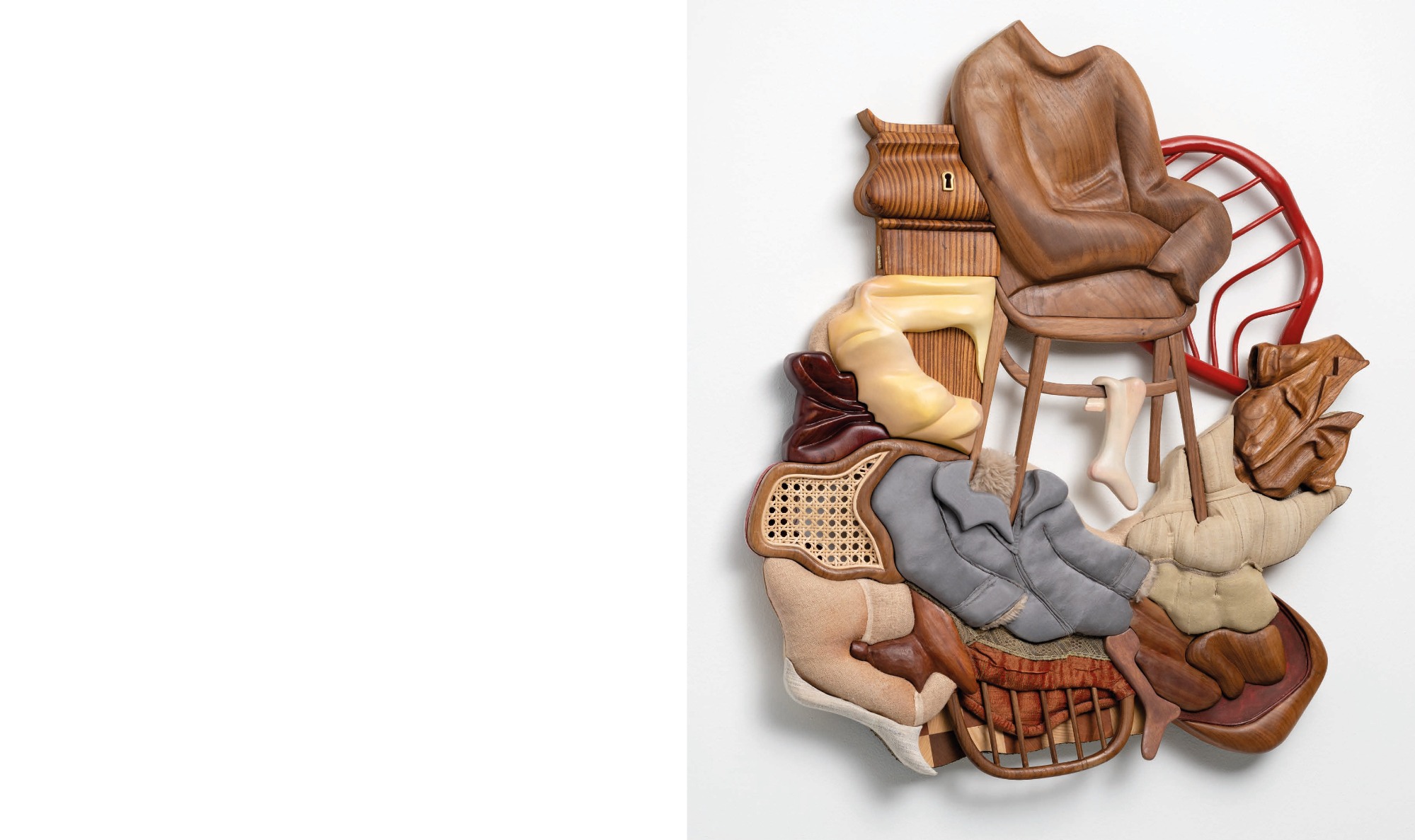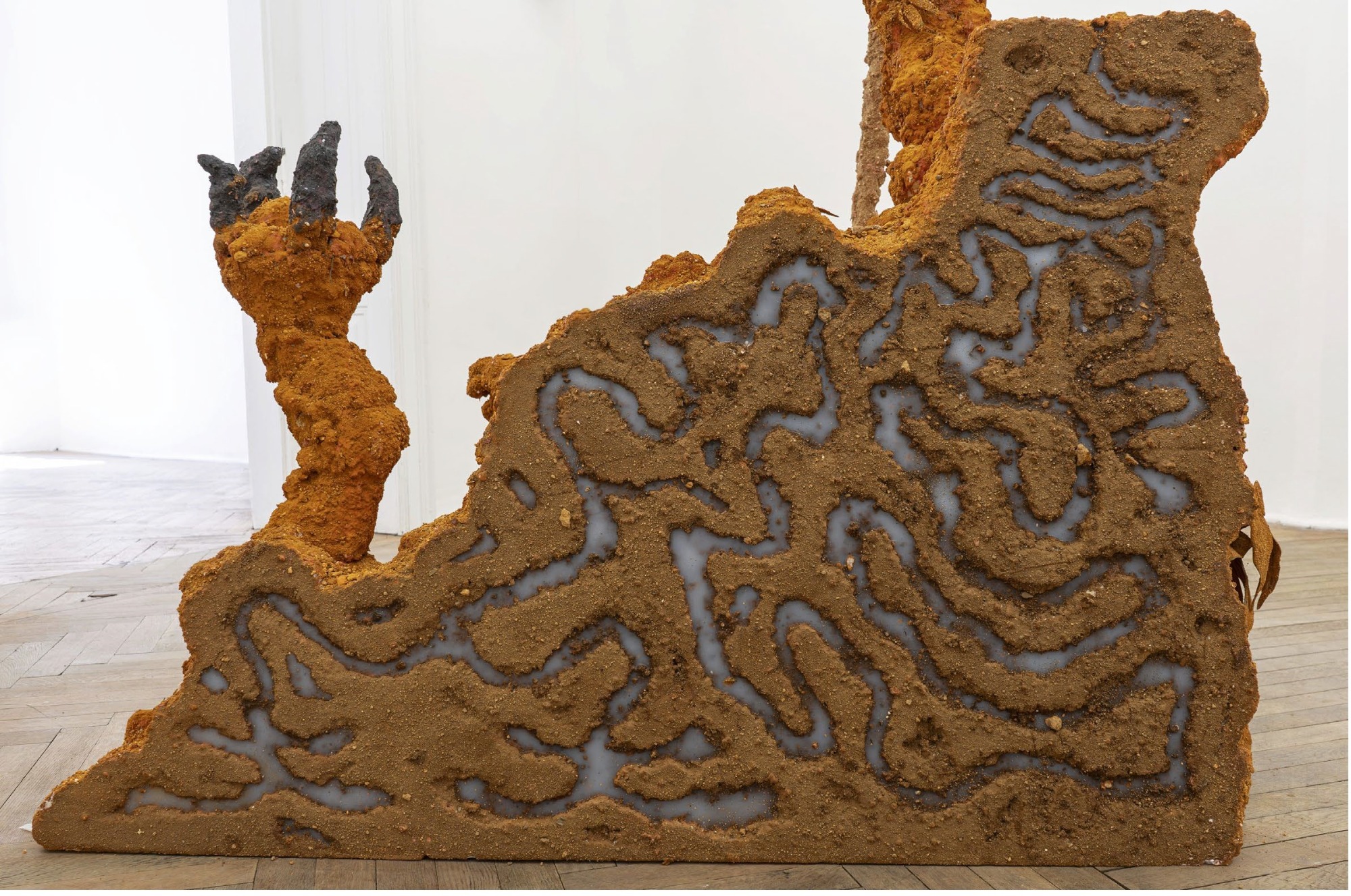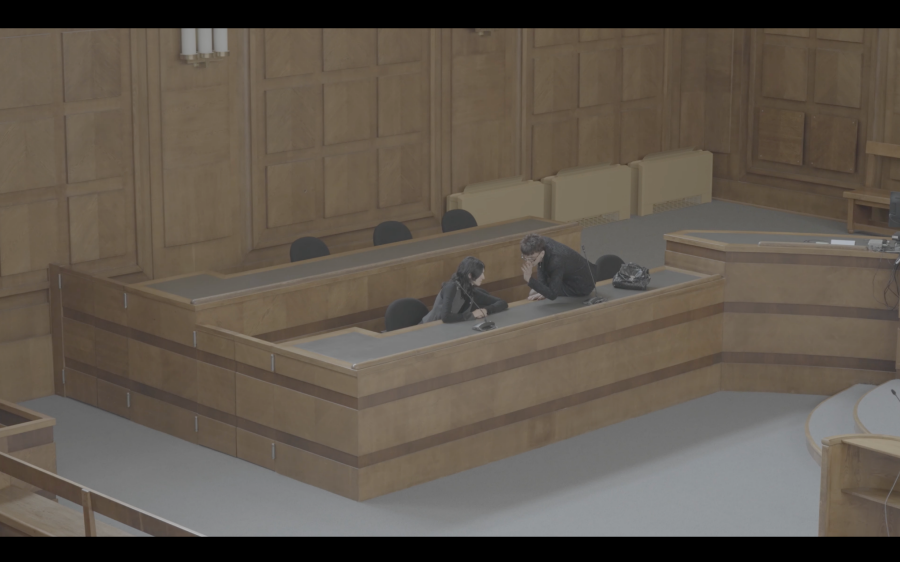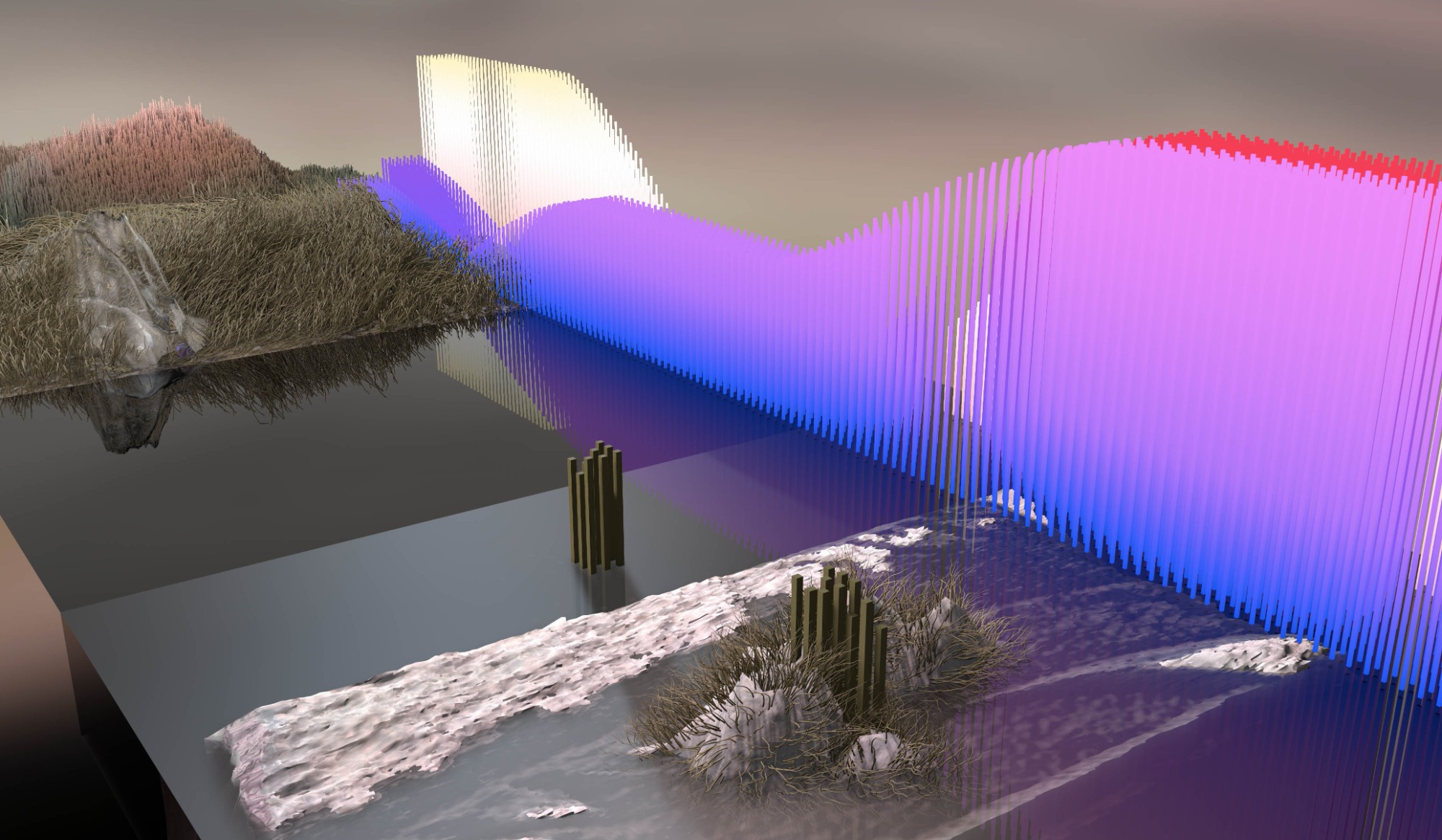Štěpán Brož, Medard Zeman
The Field of Love exhibition presents an installation combining fantasy paintings by Štěpán Brož and grotesque sculptural realisations by Medard Zeman. Together they created a temporary environment referring to the historical genre of panoramas. Their installation, however, instead of conveying an epic narrative of national history, offers us an immersive glimpse into a grotesque vision of an utopian world where tomorrow means yesterday and where even the things that can be found in the furthers parts of our imaginations can seem ordinary.
Pink Chips and Pink Potatoes, two films in which the filmmaker works with queer identity in a small community. The overarching theme for the exhibition is the complexity of identity. Imaginatively, Juri Charvat grates the pink potato into thin slices, revealing more concrete parts of his own identity. The video collage is composed of alternating footage of real unstaged actions and fictional symbolic scenes, where one can perceive the auto-fictional story of a character who went to a village party.
Translated with DeepL.com (free version)
Yeonwoo Chang
Yeonwoo Chang is an artist based in Dresden, Vienna and Seoul. In her artistic practice she deals with physical and spiritual issues that transcend history, craft, culture and nature. Her recent works show the political context of craft through ceramics.
Ceramics becomes a medium that reflects themes of natural resources, postcolonialism and craft that lead to a discourse of local art and contemporary art in a non-Western context. The Moon Jar project was born out of the impulse to live up to the moniker of a specific type of late 17th century Korean ceramic vessel from the Joseon Dynasty. It is two symmetrical hemispheres smoothly joined at their centre. During the period of Japanese colonialism, this pottery was exported abroad, thus influencing the shape of European ceramics. The specificity of Yenwoo Chang's object is the fact that the glaze of her object is composed of carefully prepared synthetic moon dust. The exhibition project addresses various aspects of the moon as a natural satellite of the Earth, but also as a source of possible territorial acquisition and cultural symbol. The utopian colonization of the lunar surface is contrasted with the pointing out of the symbolic and economic value of artistic artefacts in international museums and the postcolonial debates that accompany them. Beyond these discourses, the material of the ceramic vessel remains clay and its basal character in debates on climate issues.
Trin Alt, Tobias Izsó, Laya Laurence Mussi
Central to the collective project is an exploration of Trompe L'oeil, an artistic technique that deceives the viewer's perception through optical illusions. The aim is to bring together the practices of all the participating artists to create an immersive visual experience within the exhibition. The historical context of the Trompe L'oeil technique is intertwined with contemporary elements of interpretation such as those discussed in Norman Klein's exhibition "From the Vatican to Vegas". The exhibition itself will incorporate various components, including an airbrush mural, the incorporation of carved text directly into the surface of the walls, and the strategic placement of flat sculptural elements. These elements interact with each other, whether by overlapping painted surfaces or occupying separate spaces within the exhibition area, to foster a dynamic and thought-provoking environment for viewers to engage in.
Dana Balážová, Eva Brodská, Lucie Kralíková
The exhibition connects an elemental life-giving element and a powerful symbol preserved for many ages - fire. In the background of the creation of the installation and equally important live actions will be both the photo and video archive of the artists themselves, as well as the collaborative creation of situations associated with prepared scrums of plants, fragrant woods, rattlesnakes and elements washed by ocean waves. The central object will become the hearth as sculptural object, the rising smoke and the many-voiced (or silent) prayer as a means of connecting with ancestors present, future and past in one precious time. A purposeful time-lapse collection of video and photo material of fires from different seasons and gardens, supported by careful drying and gathering of herbs, plants and other found material will give rise to opportunities for gathering over specific scents and themes within the courtyard and the gallery itself.
Šimon Chovan
Šimon Chovan's exhibition project Almanac of Wounds presents his diploma work. It adheres to a strong material sensibility, combining organic substances such as beeswax and ochre pigment in contrast with inorganic ones such as metal or silicone. She casts, cuts, dissolves and stages her objects into complex, organized wholes that resemble structures and systems of various types: human, natural or artificial. This visual narrative creates a fictional vision in which the present meets the future, the personally acquired (such as the soil and wax from the artist's birthplace) meets the prefabricated. This singular sculptural practice touches on many contemporary themes such as environmentalism, the Anthropocene, the irreversibility of new technologies, and alliances, all of which are relevant to Chovan, but within this project the artist also focuses on the interdisciplinary concept of plasticity as defined by French philosopher Catherine Malabou - as a fundamental operation, a reciprocal overlapping of form between the empirical (or material) and the noetic (or mind); the ability to crystallize form as well as destroy it.
Markéta Slaná
Celé zasazení filmu je situováno do prostoru Vrchního soudu v Praze, který se stává pomyslnou stagí pro zkoumání symptomů současného kulturního neklidu. Soudní síň sama o sobě symbolizuje dynamické prostory, které zahrnují silné mezilidské a společenské dynamiky a vyznačují se jasnou hierarchií moci. Prostor je okupován čtyřmi performery, kteří vykonávají gesta jako šepot, příprava na řeč, přísaha, či snaha neúspěšně posouvat rigidní architekturu. Protagonisté jakoby byly aktéry a zároveň pozorovateli, pomyslná NPCs, která uvízla v soudní síni, co se neustále připravují na projev a vyprávění, k němuž ale nikdy nedojde. Vlna neoliberalismu vedla k erozi historického vědomí, rozostřila hranice mezi minulostí, přítomností a budoucností, a zanechala nás ve stavu zmatku a estetického chaosu. Pronásledují nás ztracené budoucnosti, které byly slíbeny, ale nikdy nepřišly. Co tedy zůstane, když historicita zmizí? Je to vibe. Je na čase nemít žádný program, je čas prostě jen vibovat. vibe je to, co zůstává, když všechno ostatní už zmizelo. Video čerpá inspiraci z kolektivních zkušeností, internetové kultury, sdílených deníků, vlastní choreografické praxe, principů disciplinace i emocionálního vyjádření. Cílem práce je vytvořit komplexní lyrickou situaci, která zkoumá osobní zranitelnost a zároveň zobrazuje bizarní situace jako prostředek k pochopení aktivních vztahů a společenských hranic.
Lucie Rosenfeldová
The exhibition project How to (Not) Remember Our Bodies is the outcome of a long-term artistic research on the topic of body memory in the field of reproductive medicine. The exhibition will include a newly produced film by the artist focusing on both the specific individual and collective experiences of reproductive medicine and its historical and political conditioning. It will thus build on the previous film, Uteruses and Brains, which was part of an exhibition at the Kurzor gallery curated by Jan Zálešák in 2022. In contrast to the previous film, the new film will draw on the subjective experiences of women participants in reproductive medicine in the context of Czech and Czechoslovak gynaecology, as well as historical material obtained from the NFA's medical film archive, information gathered from research at the Medical Museum in Prague, and ongoing consultations with experts in the field of bodily memory.
Karolina Raimund
Karolina Raimund (formerly Kohoutková) is an artist, curator and educator whose artistic and pedagogical practice has long focused on body design and performance, addressing feminist and queerness themes.Identitarian issues related to corporeality in her work are complemented by environmentally engaged projects. These levels are interconnected in Karolina's upcoming exhibition, which takes as its starting point an artistic intervention in the landscape that is linked to a specific place, a 3600 m2 farmland in South Moravia, which is still listed as the property of the artist's late great-grandmother. This field is part of one large whole and is thus cultivated in a similar way to the communist regime. The monoculture area is currently made up of smaller plots of land owned by several owners, which are visible only in the drawing on the cadastral map. It is almost as if they did not exist. Karolína decided to remove her great-grandmother's piece of land from this "role", so that her great-grandmother's field would be both a mediator and a pretext for haptic exploration and understanding of the landscape in its former and ideally perhaps future form. The artwork will be based on classical agrarian practice and will thematise the different phases of land care. The project is based on the need to "experience oneself"; to tune in to the life of a great-grandmother. It also stems from the fear that the earth will become even more toxic in the future.It thus builds on the ideas and practice of ecofeminism and highlights the imbalance of human and natural forces. The work will run as a longer term project respecting the natural cycle and will be presented as a sensory exhibition finding partial responses to the character and iconography of the territory through art. Field Revival will be in consultation with a member of staff from the Silva Tarouca Research Institute for Landscape and Ornamental Horticulture, a public research institution.







